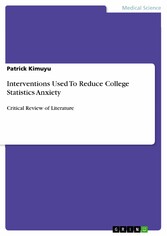Interventions Used To Reduce College Statistics Anxiety - Critical Review of Literature
von: Patrick Kimuyu
GRIN Verlag , 2018
ISBN: 9783668612099
, 21 Seiten
Format: PDF
Kopierschutz: frei
Preis: 13,99 EUR
eBook anfordern 
Mehr zum Inhalt

Interventions Used To Reduce College Statistics Anxiety - Critical Review of Literature
Document from the year 2016 in the subject Medicine - Therapy, grade: 1, Egerton University, language: English, abstract: This literature review aims at discussing the interventions that can reduce statistics anxiety among college students. To achieve this objective, a concise definition of statistics anxiety, as well as, the distinction between statistics anxiety and math anxiety is provided as the scientific rationale why the focus of this discussion is on interventions that reduce statistics anxiety, but not math anxiety in general. Statistics anxiety has become an issue of concern in higher education due to its implications on teaching and learning. In retrospect, the trends of statistics anxiety are quite alarming. This aspect is evidenced by Onwuegbuzie and Wilson (2003) who report that statistic anxiety affects 80% of behavioral and social sciences students. They also report that most degree programs require students to enroll in quantitative research and statistics courses as part of their training. These statistic courses are reported to evoke anxiety-provoking experiences among students. Similarly, Macher et al. (2013) reaffirm that statistics courses have been found to be the major source of anxiety in student's curriculum. Further evidence is provided by Dykeman's (2011) study which investigated the levels of anxiety between students in statistic courses and those in other education courses. Results of this study revealed that statistics students had lower self-efficacy (p<.01) and higher levels of anxiety (p< .05) compared to other students. As such, research on statistics anxiety has focused on the causes, as well as the statistics anxiety-reducing interventions. In this context, it is worth noting that statistics anxiety, as a construct, is different from math anxiety, which has been discussed extensively by researchers. Factor analysis reveals that statistics anxiety comprises of six dimensions: fear of statistics teacher, interpretation anxiety, computational self-concept, worth of statistics, fear of asking for help, and test and class anxiety. In contrast, mathematics anxiety has one dimension: fear of mathematics.











